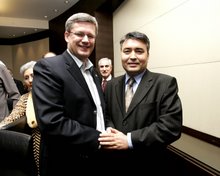
Alienated in Xinjiang
Joshua Kurlantzick, National Post Published: Tuesday, February 17, 2009
Related Topics
Uighur Muslim worshipers attend an early afternoon prayer session at the Kashgar Idgah mosque in Xinjiang province.
Nir Elias, ReutersUighur Muslim worshipers attend an early afternoon prayer session
at the Kashgar Idgah mosque in Xinjiang province.
In October, in a landmark decision, a U. S. federal judge ordered the White House to release 17 men, Muslim Uighurs from China, from Guantanamo Bay into the U. S. For six years, after they were swept up while studying in Afghanistan, the U. S. had held them at Guantanamo, though they'd long ago been cleared of being "enemy combatants." If released to China, they could be treated as dissidents and tortured or killed, and Washington had thus far failed to find another nation to take them.
The decision quickly met both cheers and fears. Among human rights advocates, the release proved a great victory, since the men clearly were not terrorists yet were suffering in prison camp. For its part, the Bush administration quickly warned the decision could allow actual hardcore militants at Guantanamo to also demand to be freed to the U. S. The White House obtained an emergency stay of the Uighurs' release and appealed the decision, though it remains unclear what President Obama, who has vowed to close Guantanamo Bay, plans to do with them.
But inside Xinjiang itself, the vast western region of China home to most Uighurs, a Muslim people ethnically close to the Turkic nations of Central Asia, virtually no one would have heard this news anyway. For while eastern China develops into a land of factories, fast cars and five-dollar lattes, far-western Xinjiang, a land more reminiscent of the Middle East than the Middle Kingdom, remains stuck in the totalitarian China of the past. While China becomes freer, in Xinjiang the heavy hand of the Chinese state still dominates people's lives, even controlling their personal religious beliefs -- and actually sparking local anger and, potentially, terrorism China long has feared.
In many ways, Xinjiang towns like Kashgar, a historic trading post near the border with Central Asia, barely resemble China. For centuries, Xinjiang, a landmass larger than much of Western Europe, was more closely tied to Central Asia. The Uighurs even had an independent state in the early 20th century. Today, in the historic central square of Kashgar, Uighur men still look West, rather than East to Beijing, for their cues; as the call of the mosque rings out, they congregate in back alleys, chewing over Iranian-style nan flat breads and haggling over hand-woven rugs.
Most Uighurs also have little interaction with their Chinese peers -- Kashgar itself is essentially divided into Uighur and Chinese areas. "I didn't really know any Chinese [students] in high school," one Uighur girl told me in Kashgar, though her classes were nearly half Chinese. "The only time the boys would meet them was when they fought."
These fights are hardly unique. For years, Uighurs have simmered against rule by Beijing. In the early-1990s, this anger exploded into large-scale street protests in several Uighur cities. Worried, China launched new policies in an attempt to better integrate Xinjiang into the rest of the country.
But Beijing's policies designed to pacify Xinjiang have backfired. In the past decade, as part of a multi-billion-dollar campaign called "Develop the West," China has encouraged vast domestic and foreign investment in Xinjiang and other western provinces, while building a modern rail and road network through the province.
Today, the Xinjiang capital of Urumqi looks like a bizarre combination of modern-day Denver and a medieval town. Against the backdrop of vast plains, new hotels and neon-lit skyscrapers now dominate Urumqi's downtown. In another part of the city, next to a new supermarket selling imported cheese and coffee, Uighurs trade handmade pots and sheep's head soup off the back of donkey carts.
Develop the West, unfortunately, has not benefited many Uighurs. As part of the program, the government has used a range of incentives to encourage westward migration by Han Chinese, who staff the new construction projects sprawling across the arid moonscape of Xinjiang's vast deserts. While Uighurs once made up over 90% of the province's population, today they comprise less than half, according to several estimates.
Now, Chinese traders and migrant workers dominate much of the economy of cities like Urumqi, even dressing up like Uighurs to appeal to Chinese tourists, who come for a glimpse of their "Old West" like Americans visiting the frontier in the 19th century. On the dusty ring roads surrounding the city, Uighur beggars sleep in alleys or stop motorists for tiny bills. According to one study by the Asian Development Bank, Xinjiang has the worst income inequality of any province in China -- a significant feat, given that supposedly "communist" China now boasts income inequality rivaling some of the most stratified Latin American nations.
Westward migration and construction also has damaged Xinjiang's fragile, arid environment, making life even tougher for local farmers trying to grow grapes and the sweet local Hami melons famed across China. Indeed, a study of Xinjiang's environmental woes by the NGO Human Rights in China found drying-up lakes, destroyed water reservoirs and other catastrophes. A recent petroleum boom in Xinjiang -- local gas production has more than doubled since 2000 -- will probably make these pollution problems far worse.
The local government also practices a subtle form of discrimination. Though Beijing reserves some government-linked jobs for Uighurs, people throughout Xinjiang told me that, at higher levels, all major positions are given only to ethnic Chinese. One study, by the Washington-based Congressional-Executive Commission on China, found that one of the organs of the local government in Xinjiang reserved 800 out of 840 positions for ethnic Chinese.
Unlike in other parts of China, where rules on personal freedom became relaxed over the past decade, in Xinjiang Beijing has retained draconian Mao-era controls. Fearing that Uighur anger will turn into radical Islam, despite no history of radicalism in the region -- many Uighurs I met downed cheap local alcohol, mixing it with soda or ice -- Beijing tightly monitors and restricts prayer. At mosques in the province, Uighurs told me, Beijing closely watches and often handpicks imams. Unlike in other parts of China, government workers in Xinjiang are not allowed to practise their religion.
According to one comprehensive report on Xinjiang by Human Rights Watch, Chinese security forces often arrest Uighur activists -- even though they have no extremist religious links -- torture them and even kill them, sometimes in public executions more reminiscent of the Taliban than modern Chinese cities like Beijing. In recent months, Beijing even has enacted new laws limiting Uighurs' ability to teach Islam to children.
China's strategy has only made the Uighurs more alienated. With the influx of Chinese migrants, Uighur small businesses in Xinjiang cities are failing, and the petroleum boom has resulted in few local hires and little revenue sent back to the province. New construction in towns like Kashgar has decimated old Uighur homes, mud-brick buildings with maze-like interior courtyards. On one visit to Kashgar, I wandered through the older, Uighur section of town, only to find many of the adobe-like homes marked for destruction. The next time I returned, most of the old courtyard homes were gone.
In some ways, the White House under George W. Bush, while publicly expressing support for the Uighurs' rights, actually helped Beijing repress them. To enlist China's support in the global war on terror, in 2002 the White House agreed to list an obscure Uighur organization, ETIM, on the State Department's roll of global terrorist networks, alongside such real threats as al-Qaeda. Beijing began using the U. S. action as pretext to enact even tighter controls in Xinjiang.
And when the Uighurs first arrived at Guantanamo, the Bush administration allowed Chinese intelligence officials to question them, according to transcripts of the Uighurs' military tribunals that I obtained--even though the State Department has repeatedly criticized Chinese intelligence for its harsh treatment of detainees. By locking them in Guantanamo, the administration essentially branded the men as terrorists, whether or not they were actually guilty --a decision that only made it harder to find any country to take them as refugees.
Ironically, after years of falsely seeing terrorism in every Uighur protest, today China may actually face a real terror threat. During the first week of the Beijing Olympics, militants launched a series of attacks in Xinjiang. In the most stunning demonstration, one group of militants allegedly rammed a bus into a police post in Kashgar and set off explosives before jumping out and stabbing the police, killing 16 people. Then, militants bombed areas of Kuqa, another town in Xinjiang.
Unfortunately, after failing to pacify Xinjiang when the region faced no terror threat, Beijing now has no idea how to combat real terror. Cracking skulls has not allowed Chinese forces to gain access to terror cells -- one reason why even Chinese officials admit they know little about Uighur militant organizations that may be forming. Indeed, Beijing's repression actually may be creating what it long has feared -- real, well-organized Uighur militant groups, which clearly did not exist in the past.
jkurlantzick@ceip.org - Joshua Kurlantzick is a fellow at the Pacific Council on International Policy and author of Charm Offensive: How China's Soft Power is Transforming the World.






No comments:
Post a Comment